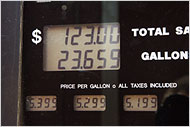 There is, apparently, a place in California where gas is now $5.20 a gallon.
There is, apparently, a place in California where gas is now $5.20 a gallon.
But it’s still not as bad as Polska, where gas (due primarily to taxes) is about $7 a gallon (though sold in liters for zloty, of course). When you take into account the significantly lower wages compared to the average here, you end up paying over $15 a gallon.
When gas prices get to be $5 a gallon throughout the States (and it will probably happen ridiculously fast), will we finally get serious about alternatives? Will people start, at the very least, buying more fuel-efficient cars?
Americans, however, are not shunning these beasts. Far from it. Auto industry figures show that after a two-year slump, sales of the gas guzzlers are up over 2006 — in some cases, way up.
The numbers for large SUVs rose nearly 6 percent in the first quarter of 2007, and the April figures were up 25 percent from April 2006, according to automakers’ statistics provided by Edmunds.com, an automotive research Web site. (SF Chronicle)
Probably not.
Most Stunning View in Town Is the One at the Pump – New York Times
Here are the sales figures for hybrids.
I was curious about this so I did more digging. SUV sales are down this year compared to the same time last year (the SF Chronical article you cite is a year old). The fact is that SUV sales have been pretty volatile for the last few years, while fuel efficiency trends have been on a steady increase.
Also, what qualifies as an “SUV”? The very popular Honda CR-V qualifies I guess, but it’s a small 4-cyl car-based SUV that gets car-like mileage compared to something like the Escalade. Lumping truck- and car-based SUVs together can mask a lot of movement towards fuel efficiency.
There’s also indication that high fuel prices are causing behavior changes that might not be reflected merely in SUV sales. Mass Transit ridership is up (Mass Transit ridership is way up and people are driving less.
So the short story is that there are behavior changes going on and the SUV sales rate is probably not a reliable indicator.
I’m amazed at the prices of petrol. I remember when we paid 49 Canadian cents for a litre (God knows how much that is per gallon). When we went back home, we had a hard time finding anywhere that sold petrol for 108 Canadian cents per litre.
Still, the number of huge, hulking, ginormous 4×4 is amazing. Unless you’re a farmer or live in an area where there are no paved roads, why, why, why would you need one?
I think prices of petrol in Europe (in general) are stupid, but I don’t think the Europeans drive as much as the Canadians or the Americans. Still, it’s madness.
Thud, I probably should have checked more carefully at the date. Still, what spurred me into writing this was a report I heard on NPR last week that stated the same thing, generally, the Chronicle article was getting at: an increase in sales over the last quarter, taken with the view of the general volatility of the SUV sales, seems to indicate that gas prices have not had a significant impact on SUV sales when looking at the big picture.
Mass Transit use might be up, but that’s only in areas where it exists as a viable option. It’s not a viable option for me. If, however, enough people demanded it, I think the Greenville Transit Authority (or whatever it might be called) would introduce more lines. As far as I know, people are not demanding it, though.
“fuel efficiency trends have been on a steady increase”
While I’ve read a few places that state Model-T’s got 20 mpg, it seems more probable that they only got 12-14, as I read on a Model-T aficionado page. That means that in one hundred years, fuel efficiency has not increased that much, as the Department of Transportation indicates. Indeed, in 1980, the average for passenger cars was 16 mpg. Even if the Model T only got 8 mpg, that’s an increase of 100% efficiency in just 70 years. As it stands, it appears there was a 33% increase. From 1980 to 2006, it was 37%. Yet overall, that means within 100 years, there’s been only an increase from 12-14 mpg to 22 mpg (2006 figure). That’s not even a 100% increase. In one hundred years! Compare that to the exponential growth of processor speed.
If the incentive had been there, cars today could be getting at least 70 mpg. 100 would not be unreasonable. But there has not been an incentive. And it appears there still isn’t.
Kinuk, I remember prices in the 1980’s that were in the 80’s — cents, that is. And when I first started driving, I remember being able to but $5 in my car and having almost a half tank of gas.